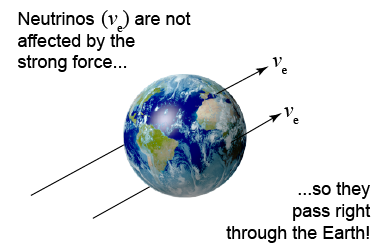|
What force causes beta decay, in which a neutron is converted into a proton and an electron? The neutron has no electric charge, so its decay cannot result from the electromagnetic force. The electron is not a nucleon, so it is not affected by the strong nuclear force. The gravitational force is far too weak. Since none of these three forces can be responsible, the existence of beta decay is evidence for the presence of a fourth force of nature, the weak nuclear force. 
|
Radioactivity was discovered in 1896 by French scientist Henri Becquerel (Marie Curie’s professor). In 1900, Becquerel showed that beta rays were identical to electrons, recently discovered by J. J. Thompson. Over the next few decades, physicists realized that whenever beta decay occurred, some energy and momentum were missing and not accounted for by the proton and electron. Based on this evidence, Austrian theorist Wolfgang Pauli argued in 1930 that there had to be another, unseen particle produced by beta decay that carried no charge and had little or no mass. 
 |
There are actually three known types of neutrinos: electron neutrinos (νe), muon neutrinos (νμ), and tau neutrinos (ντ). The subscript “e” identifies an electron neutrino. All particles have corresponding antiparticles. For example, the positron is an antielectron. The bar indicates an antineutrino; therefore, the particle in the equation is an electron antineutrino. 
|

|
 In 1934, Italian physicist Enrico Fermi proposed a model for the weak nuclear force governing beta decay that incorporated Pauli’s particle, which Fermi called the neutrino. Because it is so hard to detect, the neutrino (actually the antineutrino!) was not experimentally discovered until 1956 by Americans Frederick Reines and Clyde Cowan. Neutrinos are not affected by the electromagnetic force because they have no charge. They are also not affected by the strong nuclear force, which allows them to pass right through the Earth! In fact, neutrinos are only affected by the weak nuclear force.
In 1934, Italian physicist Enrico Fermi proposed a model for the weak nuclear force governing beta decay that incorporated Pauli’s particle, which Fermi called the neutrino. Because it is so hard to detect, the neutrino (actually the antineutrino!) was not experimentally discovered until 1956 by Americans Frederick Reines and Clyde Cowan. Neutrinos are not affected by the electromagnetic force because they have no charge. They are also not affected by the strong nuclear force, which allows them to pass right through the Earth! In fact, neutrinos are only affected by the weak nuclear force. 
|
Beta decay occurs through the weak nuclear force, which is one of the four fundamental forces of nature. The weak force has its name because this force is about a million times weaker than the strong nuclear force and the electromagnetic force. The weak force also operates at shorter distances than even the strong force. All types of matter are affected by the weak force however, the effects of the weak force are typically only observed when strong or electromagnetic forces are absent or inactive. 
|
The effects of the weak nuclear force are important for carbon-14 dating, which you will learn about on the next two pages. Beta decay also occurs in the core of the Sun as part of the nuclear fusion reaction that converts two hydrogen atoms into a deuterium atom. Beta decay in the Sun’s proton–proton reactions produces positrons instead of electrons. 
|
In 1968, Americans Sheldon Glashow and Steven Weinberg and Pakistani Abdus Salam proposed a theory for the weak nuclear force that went beyond Fermi’s earlier model. The new model argued that the weak force is mediated through three not-yet-seen and massive particles, the W+, W−, and Z0 bosons. The particles were detected in 1983 by a large collaboration led by Italian physicist and inventor Carlo Rubbia and Dutch physicist Simon van der Meer. 
|
| |
|

